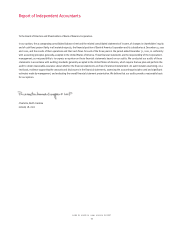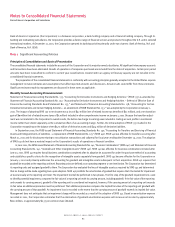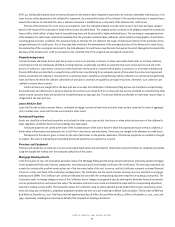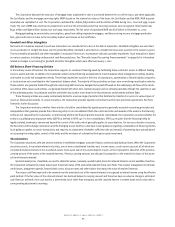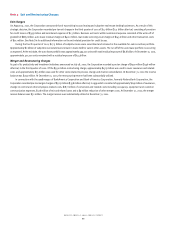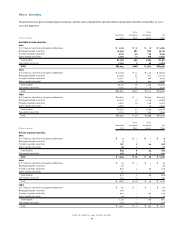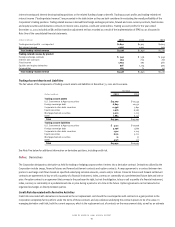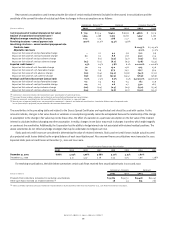Bank of America 2001 Annual Report Download - page 89
Download and view the complete annual report
Please find page 89 of the 2001 Bank of America annual report below. You can navigate through the pages in the report by either clicking on the pages listed below, or by using the keyword search tool below to find specific information within the annual report.
BANK OF AMERICA 2001 ANNUAL REPORT
87
Income Taxes
There are two components of income tax expense: current and deferred. Current income tax expense approximates cash to be paid or refunded for
taxes for the applicable period. Deferred tax assets and liabilities are recognized due to differences in the bases of assets and liabilities as measured
by tax laws and their bases as reported in the financial statements. Deferred tax expense or benefit is then recognized for the change in deferred tax
liabilities or assets between periods.
Recognition of deferred tax assets is based on management’s belief that it is more likely than not that the tax benefit associated with certain
temporary differences, tax operating loss carryforwards and tax credits will be realized. A valuation allowance is recorded for the amount of the
deferred tax items for which it is more likely than not that realization will not occur.
Retirement Benefits
The Corporation has established qualified retirement plans covering substantially all full-time employees and certain part-time employees. Pension
expense under these plans is charged to current operations and consists of several components of net pension cost based on various actuarial
assumptions regarding future experience under the plans.
In addition, the Corporation and its subsidiaries have established unfunded supplemental benefit plans and supplemental executive retirement
plans for selected officers of the Corporation and its subsidiaries that provide benefits that cannot be paid from a qualified retirement plan due to
Internal Revenue Code restrictions. These plans are nonqualified under the Internal Revenue Code, and assets used to fund benefit payments are not
segregated from other assets of the Corporation; therefore, in general, a participant’s or beneficiary’s claim to benefits under these plans is as a
general creditor.
In addition, the Corporation and its subsidiaries have established several postretirement healthcare and life insurance benefit plans.
Other Comprehensive Income
The Corporation records unrealized gains and losses on available-for-sale debt securities and marketable equity securities, foreign currency translation
adjustments, related hedges of net investments in foreign operations and gains and losses on cash flow hedges in other comprehensive income in
shareholders’ equity. Gains and losses on available-for-sale securities are reclassified to net income as the gains or losses are realized upon sale of
the securities. Other-than-temporary impairment charges are reclassified to net income at the time of the charge. Translation gains or losses on foreign
currency translation adjustments are reclassified to net income upon the sale or liquidation of investments in foreign operations. Gains or losses on
derivatives are reclassified to net income as the hedged item affects earnings.
Earnings Per Common Share
Earnings per common share is computed by dividing net income available to common shareholders by the weighted average common shares issued
and outstanding. For diluted earnings per common share, net income available to common shareholders can be affected by the conversion of the
registrant’s convertible preferred stock. Where the effect of this conversion would have been dilutive, net income available to common shareholders
is adjusted by the associated preferred dividends. This adjusted net income is divided by the weighted average number of common shares issued and
outstanding for each period plus amounts representing the dilutive effect of stock options outstanding and the dilution resulting from the conversion
of the registrant’s convertible preferred stock, if applicable. The effects of convertible preferred stock and stock options are excluded from the com-
putation of diluted earnings per common share in periods in which the effect would be antidilutive. Dilutive potential common shares are calculated
using the treasury stock method.
Foreign Currency Translation
Assets, liabilities and operations of foreign branches and subsidiaries are recorded based on the functional currency of each entity. For certain of the
foreign operations, the functional currency is the local currency, in which case the assets, liabilities and operations are translated, for consolidation
purposes, at current exchange rates from the local currency to the reporting currency, the U.S. dollar. The resulting gains or losses are reported as
a component of accumulated other comprehensive income (loss) within shareholders’ equity on an after-tax basis. When the foreign entity is not a
free-standing operation or is in a hyperinflationary economy, the functional currency used to measure the financial statements of a foreign entity is
the U.S. dollar. In these instances, the resulting gains and losses are included in income.


